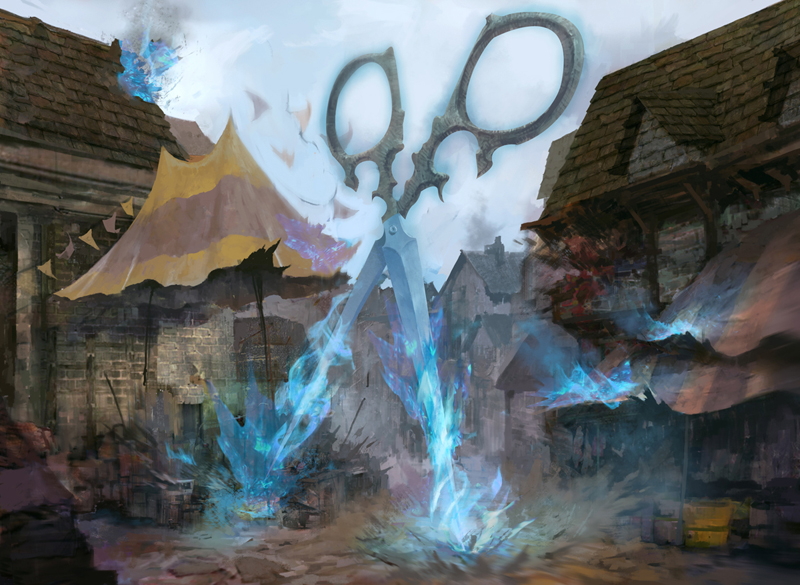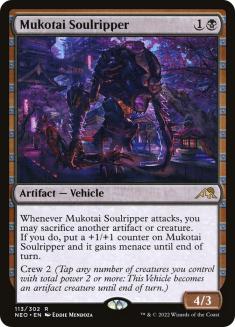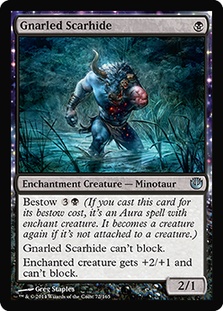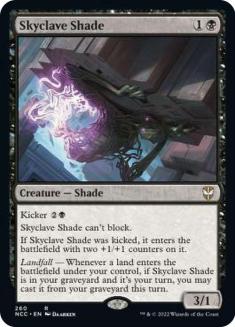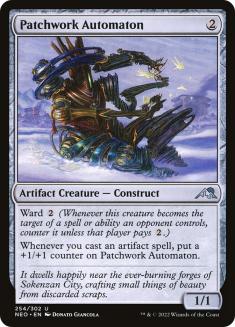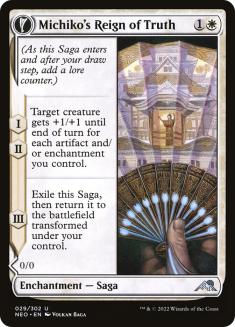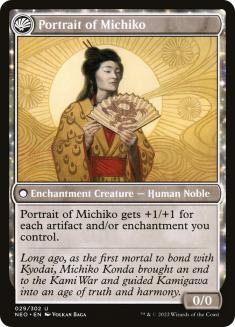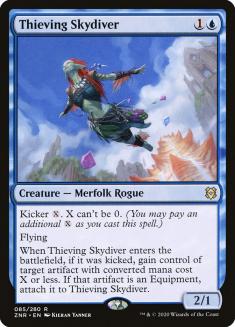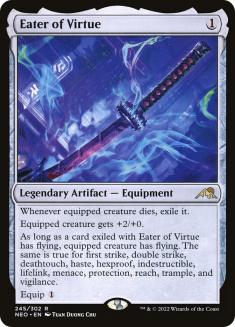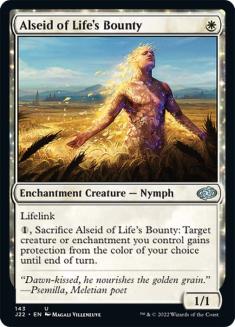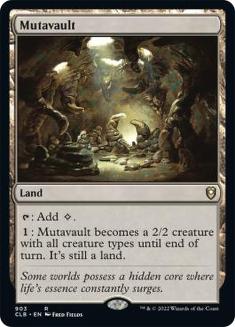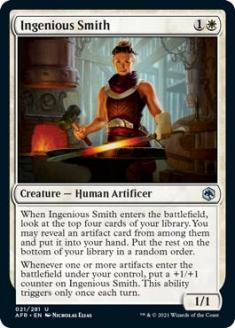Pioneer has been greatly changed by Kamigawa: Neon Dynasty and I’m loving the look of the format. So many different cards are seeing play, and some of the new Vehicle synergies are giving new life to cards long forgotten. One of my favorite things happening right now is Parhelion II getting reanimated or cheated onto the battlefield. But that wasn’t the first place I went looking.
Last week, I went through my Top 8 Kamigawa: Neon Dynasty cards that I thought would shape Pioneer. I had a few misses, including Greasefang, Okiba Boss, but most of the cards on that list are already hitting some 5-0s in Leagues. One card in particular looked like a juicy piece of fruit growing fat on the vine, and I knew I had to take it for a spin.
My first foray into Pioneer with new cards featured a Mono-Black Aggro deck with a spotlight on Mukotai Soulripper taking the place of Smuggler’s Copter from the old lists. Of course, to play Mukotai Soulripper, we had to change the creatures a bit. After all, Night Market Lookout doesn’t crew Mukotai Soulripper, so I went lookin’ for some replacements.
Because Mukotai Soulripper needs two power from an untapped creature to crew, I figured it was important for all of our creatures to enter the battlefield untapped. That means we’re playing some loosey-goosers, and none of them can block! Pretty scary stuff against other aggro decks, if I’m being honest. Regardless, I wanted to bring the Rankle, Master of Pranks back so I could do some people dirty, and nothing was going to stand in my way.
Creatures (24)
- 4 Gnarled Scarhide
- 4 Bloodsoaked Champion
- 4 Scrapheap Scrounger
- 4 Knight of the Ebon Legion
- 3 Rankle, Master of Pranks
- 3 Murderous Rider
- 2 Skyclave Shade
Lands (24)
Spells (12)
Sideboard

In my first match, my opponent sideboarded in Pithing Needle and named Mukotai Soulripper on the first turn. I’d say that’s a pretty good omen that we’re on the right track! Mukotai Soulripper does everything you want it to do, and honestly plays a lot like a differently angled Smuggler’s Copter. Instead of getting that loot, you get a bigger body that offers a sacrifice outlet. This deck doesn’t do a great job of exploiting said outlet, but can utilize it without much downside thanks to so many recursive creatures.
After starting 3-0, I ran head-first into _znt_, the trophy leader from the previous Pioneer season on Magic Online (MTGO). He’s known for playing aggressive decks, so I felt like I was going in at a disadvantage, seeing as my creatures refuse to block. Regardless, I knew the match was going to be tough, so you can imagine my surprise when he started the game off with a Gingerbrute. After a few turns, it was apparent he was playing Ensoul Artifact, a card and deck that had fallen off pretty hard in the last few years, but the updates from Kamigawa: Neon Dynasty looked stellar.
After a tight match, it was clear that the new cards really put it over the top. I asked nicely for his list, and he sent it to me. I promptly went 5-0 in the first League I tried with the deck. Since I was streaming, and there isn’t a ton of Pioneer content on Twitch, my 5-0 and chatter about the deck ended up sparking a 24-hour format upheaval, all because _znt_ broke it.
Creatures (17)
Lands (21)
Spells (22)

Patchwork Automaton was on my radar while doing my Top 8 Pioneer cards, but it’s pretty difficult to evaluate without playing with or against it. On paper, it looks rather weak, but in practice, it becomes large and is very stressful on the opponent’s mana to actually kill it. You can get it out of range of Shocks quickly, and it usually takes the opponent’s entire turn to remove it from the battlefield. The only real downside is that it doesn’t trigger when you play Darksteel Citadel, but only when you actually cast artifacts, which is different from how Ingenious Smith works.
The play patterns involving Patchwork Automaton are pretty sweet. Starting with a Springleaf Drum on the first turn allows you to cast Automaton on the second turn, continuing with another one-mana artifact that pumps it. After a while, it becomes clear that Patchwork Automaton’s difficulty to kill makes it an ideal starter against most interactive decks.
While Patchwork Automaton impressed me, it was nothing compared to Michiko’s Reign of Truth.
I had this one high on my Pioneer Top 8 list from last week, as I knew it would effectively replace All That Glitters in decks that don’t care about Auras. The burst of damage from both is so high that you rarely need it for more than two turns. The fact that it targets instead of being an Aura means you’re less vulnerable to spot removal like Fatal Push. If the game continues after targeting your evasive creature twice, you’re rewarded with the biggest creature humanity has ever seen. Suffice it to say that Portrait of Michiko is large, and one hell of a threat considering how cheap it was to start, and how impactful each chapter is.
The play patterns with Michiko’s Reign of Truth are interesting, to say the least. You can save it for the third or fourth turn to do bursts of damage, or you can use it early to pick off a few points while starting the journey to a large threat. In the late-game, you can even return one to the battlefield with Lurrus of the Dream-Den. It is one of your best draws at nearly all points in the game.
Your deck is also chock-full of evasive targets for Michiko’s Reign of Truth, as targeting Gingerbrute or Ornithopter makes for some big damage that can’t be chumped. When combined with Ensoul Artifact, you’re looking at huge bursts of damage spread around nicely, making traditional sweepers and even spot removal lackluster in the face of your diversity.
Prepping for the Pioneer PTQ
The day after I played this Ensoul deck for the first time, I knew that I was going to play it in the Pioneer PTQ on Saturday on Magic Online. It just felt like “it,” and I had a leg up because I already knew what changes I wanted to make. If a good number of people in the PTQ would be playing the mirror, I wanted a little bit of technology to make the games a bit easier. Decks like Azorius Ensoul are volatile, offering explosive draws that are hard to beat when you lose the die roll. If you don’t have some sort of cheap piece of interaction, or overwhelming hate from the sideboard, chances are you’re going to get knocked down a peg. That’s just the nature of the beast. Here’s the card I wanted to beat the mirror.
While it costs three mana to steal anything, that effect is brutal against anyone trying to suit up their permanents with Ensoul Artifact. In fact, I played a few matches against the mirror to test it out beforehand, and Springleaf Drum made everything extremely easy. I don’t even know what else to say. It just worked, and it worked well.
After getting final preparations done for the PTQ the night before, I went to sleep happy knowing that I was going to register this in the morning.
Creatures (17)
Lands (21)
Spells (22)

My first match of the event was against Cain Rianhard, aka sneakymisato, who had used Izzet Phoenix to win the Monthly ManaTraders Event a few weeks prior. I knew that Cain was one of the best players in the field, so it was pretty exciting to have such a powerful opponent in the first round. It would be a true test of the deck, and of me.
In the first game of the tournament, I made a bad call that I tried to correct on the same turn. I ended up missing one point of damage from Michiko’s Reign of Truth because I didn’t cast my Portable Hole pre-combat. The rub? There were no targets on the other side of the field, but The Blackstaff of Waterdeep didn’t have relevant targets, so I was hesitant. After realizing my mistake, I tried to shake it off and keep fighting. A few turns later, Cain ran a sequence that involved transforming Thing in the Ice and returning four copies of Arclight Phoenix that eventually led to my doom. He ended the game at one life, and I felt absolutely horrible.
I won the second game easily, but lost the third game in a landslide to a ton of removal and two quick Arclight Phoenixes. That loss by one point in the first game shook me badly, and I knew I had to win out for the rest of the day to have a shot at any real prizes.
My second match came against a deck I had never seen before. Well, I suppose that isn’t entirely true. I had seen it before, but this version was an entirely different animal. Jund Sacrifice, eat your heart out.
Creatures (14)
Planeswalkers (4)
Lands (23)
Spells (19)

I couldn’t find the original list from the PTQ, but this updated version took second in the Pioneer Challenge the next day. Suffice it to say that Ensoul Artifact struggles quite a bit against Karn, the Great Creator mixed with a bunch of cheap removal! I ended up losing a close three-game set against this deck, mostly due to the massive tempo break from Karn, the Great Creator and Fatal Push. I don’t want to say that this deck is Ensoul’s worst matchup, but I can’t think of many decks I would dread playing against more than this one.
After an 0-2 start in the PTQ, my day was shot and my spirits were low. However, that meant I got to spend the day hanging with Kali and relaxing, but I still managed to do some work on the list through Discord with my buddy Taylor Spain. He ended up battling in the Pioneer Challenge a few hours later, and ended up making Top 8 with this list, and I highly recommend going this direction.
Creatures (18)
Lands (22)
Spells (20)

Eater of Virtue is a lot better than it looks on paper. All your creatures have some sort of cool keyword ability that will be great on another creature. Imagine giving your Ensoul Artifact creature flying because they killed your equipped Ornithopter! What about haste from Gingerbrute? All your early creatures can pick up this sword and deal some real damage for cheap, and then future creatures gain all the abilities from the souls trapped in the blade. I’m still not sold on the second copy, because drawing two seems like a nightmare due to the legendary rule, but I’ve liked it more than Ghostfire Blade, as the toughness boost doesn’t usually offer much for this archetype.
On Saturday morning before the PTQ, I pulled this card into my deck to see what it would look like. Using it to protect Lurrus is a no-brainer that we’ve seen countless times over the last few years. However, I wasn’t sold on it being good enough to protect your Ensoul Artifact creature. It just costs too much sometimes. After playing against an opponent who had it when I was playing spot removal, it became apparent that a few copies would be wanted in the deck, as you have extra mana lying around all the time.
After playing about ten matches with the deck, I noticed how important it was to have a target for Michiko’s Reign of Truth after your last creature on the battlefield got popped. Since the second trigger happens during your main phase, you can activate Mutavault during your upkeep so that you still have a valid target for that chapter. On top of that, Mutavault just insulates you from all manner of sweeper effects, and lets you use more mana on average when you’re trying to peck every last point of damage out of your opponents. Treasure Vault was mediocre at best, so I think the move to playing an extra land and four copies of Mutavault is warranted.
I’ve seen some lists moving toward Ingenious Smith. I can’t say I believe in it yet. While I think the card is obviously great, as it is one of the better additions to Modern artifact decks over the last year, is it better here? It can just miss too often because we’re playing so many lands and enchantments. While both are solid, they perform different functions and I doubt you can play both. After playing with Patchwork Automaton for a few days, I can’t imagine playing something else in that slot.
Final Thoughts
It seems as if Kamigawa: Neon Dynasty is here to stay in Pioneer, and I’m really enjoying how things are starting to shape up. With all the artifact synergy and Vehicles, the set feels a lot like Kaladesh in terms of power level and number of viable options. Azorius Ensoul gained a lot from the new set, but we’re nowhere close to finding the optimal build just yet. With more eyes on the format, it will only be a matter of time before the one true version emerges and crushes anyone not playing Vandalblast or similar.
The raw power of Ensoul Artifact combined with the longevity of Lurrus of the Dream-Den and Michiko’s Reign of Truth means we can win short games and long games. Mutavault and other utility spells allow us to use all our mana on basically every turn, which in my experience leads to easy victories in formats like Pioneer. As long as you and your opponent are both doing powerful things, the person who uses the most mana is probably the person most likely to win.
The new era of Affinity-style decks is upon us. Tremble ye mighty, and despair, for Patchwork Automaton comes for us all. ‘Tis only a matter of time before the Shrapnel Blast dawn.

